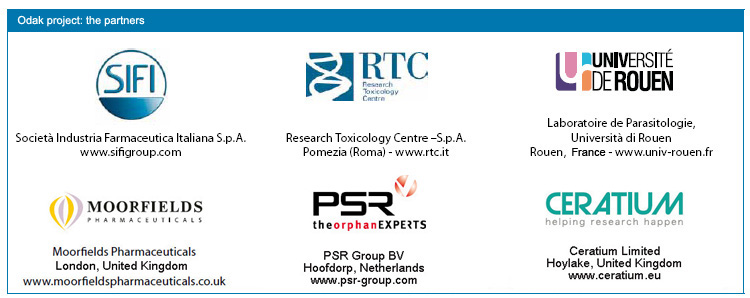News insight about drug therapy for Acanthamoeba keratitis. We asked for an update from Antonino Asero, PhD, project director of S.I.F.I. S.p.A., the ophthalmic company leading ODAK, the European research and industrial development project targeting AK drug treatment.
Dr Asero, would you please sum up the characteristics of this kind of keratitis?
Acanthamoeba Keratitis (AK) is a rare but severe and seriously debilitating corneal infectious disease. It is caused by Acanthamoeba spp., a ubiquitous protozoan that is present in air, soil and water1. Up to 85% of AK cases occur in contact lenses wearers caused by improper lenses handling and poor hygiene. The disease can occur also after corneal trauma, particularly in rural environments. Although AK incidence is low (1 in 100,000 in the EU), for the patients it is a potentially devastating ocular infection causing acute pain, vision impairment and, without proper treatment, even eye enucleation and blindness.
Why is this disease so devastating?
AK’s destructive impact is due to the infecting agent Acanthamoeba spp, a protozoan whose lifecycle includes a dormant resilient cyst stage and an infective active motile trophozoite stage. Trophozoite encystment allows the microorganism to survive under adverse environmental conditions. This dormant phase is the main cause of the disease persistence.
Which are the clinical signs and symptoms of AK?
The clinical signs of AK can include epithelial micro-erosions eventually evolving into patchy anterior stromal infiltrates, corneal ulcers, melting and dense corneal abscesses in the later phases of the disease. Typically, perineural involvement is characterized by severe ocular pain.
The symptoms are usually similar to those of other ocular infections (eye pain, eye redness, eye irritation, blurred vision, photophobia and excessive tearing) and they can persist for several weeks.
What is the current therapeutic approach to treat this rare keratitis disease?
To be effective a treatment must include cysticidal drugs that can kill both phases of the protozoan lifecycle in order to eradicate the disease.
Currently there is no agent approved for the treatment of AK in any country. Nevertheless in recent years the (off label) use of anti-amoebic agents, such as biguanides and diamidines, has greatly improved the disease treatment. In particular the use of biguanides when the treatment is started in the early stages have a very effective therapeutic role on AK. In fact the pain relieve is rapid and the active infection is usually eradicated after 4 weeks as opposed to 4 months or longer in cases of treatment with propamidine and neomycin.
Polihexanide Biguanide (PHMB) and Chlorhexidine are the only available and consistently cysticidal agents for AK. Typically the treatment involves a biguanide (PHMB 0.02% or Chlorhexidine 0.02%) and a diamidine, although there is no clinical data indicating that this combination is more effective than monotherapy with PHMB.
Recent ODAK research has shown this treatment provided good outcomes in a majority of patients (90%)3 and, if started early, led to full vision recovery.
The treatment regimens, however, have not been standardized and it is still missing a significant assessment of safety and efficacy data4as required by EU as well as international guidelines for drug approval.
What is the aim of the ODAK project in this context?
ODAK (Orphan Drug for Acanthamoeba Keratitis) is a European research project aiming to develop a stable and safe formulation of PHMB and to provide an effective drug treatment for Acanthamoeba keratitis.
PHMB has already been recognized as an Orphan Drug to treat Acanthamoeba Keratitis by the EMA (European Medicines Agency) following an application submitted by SIFI.
In the ODAK project SIFI is the leading company with the collaboration of European Partners (see box) with complementary experiences and specific know-how in the clinical management of Acanthamoeba keratitis. The ODAK project is co-funded by the European Commission within FP7 (Grant Agreement n. 305661) and will run for 60 months.
The research and development activities include laboratory experiments of pharmaceutical technology, pharmacokinetics /pharmacodynamics and toxicology, clinical studies with patients and a phase of industrial development of the final product.
Can centers specialized in the treatment of infectious eye diseases be involved in this project, could they join the project and how?
By now pre-clinical trials are in progress in order to identify the most stable and safe formulation.
These trials will run for around 24 months and be followed by clinical trials to determine safety and efficacy on human subjects.
The essential basis to develop the clinical program is a retrospective study performed at two clinical centers of the greatest importance: London Moorfields Eye Hospital (Prof. John Dart) and Milan S. Raffaele (Dr. Paolo Rama).
Thereafter for the clinical trials of efficacy it will be necessary to enroll a sufficient number of patients to be a statistically robust study.
It is easy to understand that as Acanthamoeba Keratitis is a rare disease in this phase it will be necessary and desirable to involve research centers, primarily y engaged in the recruitment of AK patients in order to achieve the required target number of patients for the trial.
Where our readers can find some more information about ODAK project?
If your readers are interested in knowing something more about ODAK they could visit the website of the project www.odak-project.eu or send an e-mail to clinicians@odak-project.eu.
References
1. Schuster FL, Visvesvara GS. Opportunistic amoebae: challenges in prophylaxis and treatment. Drug Resist Updat. 2004 Feb;7(1):41-51.
2. Claerhout I, Goegebuer A, Van Den Broecke C, et al. Delay in diagnosis and outcome of Acanthamoeba keratitis. Graefes Arch Clin Exp Ophthalmol. 2004 Aug;242(8):648-53.
3. Seal D. Treatment of Acanthamoeba keratitis. Expert Rev Anti Infect Ther. 2003 Aug;1(2):205-8.
4. Dart JK, Saw VP, Kilvington S. Acanthamoeba keratitis: diagnosis and treatment update 2009. Am J Ophthalmol. 2009 Oct;148(4):487-499.
Leggi l’intervista in lingua italiana
Dr. Carmelo Chines
Direttore responsabile

